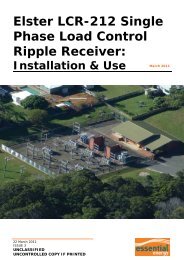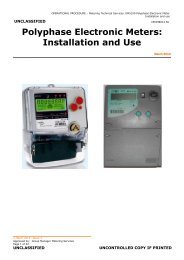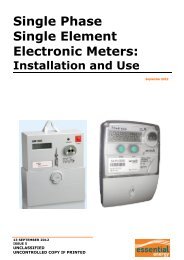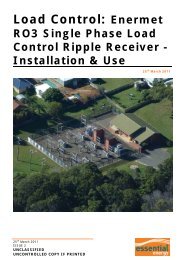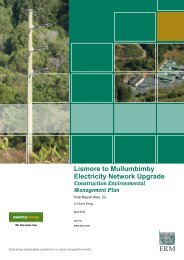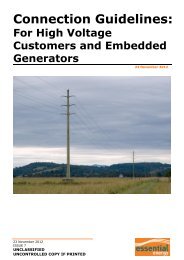Full Version - Essential Energy
Full Version - Essential Energy
Full Version - Essential Energy
You also want an ePaper? Increase the reach of your titles
YUMPU automatically turns print PDFs into web optimized ePapers that Google loves.
Notes to the Financial Statements<br />
for the year ended 30 June 2005<br />
(b) Credit Risk Credit risk represents the loss that would be recognised if counterparties failed to meet their<br />
financial obligations.<br />
The credit risk of financial assets, excluding investments, of the Corporation which have been recognised on the Statement<br />
of Financial Position is reflected in the carrying amount net of any provision for doubtful debts.<br />
The Corporation minimises concentrations of credit risk by undertaking transactions with a large number of customers and<br />
counterparties in Australia. The Corporation is not materially exposed to any individual customer or counterparty.<br />
Credit risk related to derivative contracts is minimised by ensuring counterparties are approved under the Masters Agreements<br />
of the International Swaps and Derivatives Association Inc (ISDA).<br />
Foreign exchange contracts are subject to credit risk in relation to the relevant counterparties, which are principally large banks.<br />
The maximum credit risk exposure on foreign exchange contracts is the full amount of foreign currency the Corporation pays.<br />
88<br />
(c) Net Fair Value of Financial Assets and Liabilities<br />
Financial instruments are carried at net fair value unless stated otherwise. These are disclosed in note 22(a) above.<br />
Other than loan debt which is actively managed under a risk management agreement with NSW Treasury Corporation (TCorp),<br />
financial assets and liabilities are not readily traded on organised markets in standardised form.<br />
All financial instruments are disclosed on the Statement of Financial Position.<br />
(d) Derivative Financial Instruments<br />
The Corporation is exposed to changes in interest rates, foreign exchange rates and commodity prices from its activities. The following<br />
derivative instruments are used to hedge these risks: interest rate futures contracts, forward foreign exchange contracts and futures<br />
commodity price contracts. Derivative financial instruments are not held for speculative purposes.<br />
(i) Electricity Purchases<br />
The Corporation enters into wholesale market contracts to minimise exposure to fluctuations in wholesale market electricity prices.<br />
The Corporation’s policy is to manage its exposure in line with the forecast volumes of committed retail customers.<br />
For its franchise load, the Corporation operates under the Electricity Tariff Equalisation Fund (ETEF), administered by NSW Treasury.<br />
Under the ETEF, the Corporation pays a set price for its electricity purchases and is not exposed to pool price variation.<br />
For its contestable load, the Corporation’s policy is to actively manage the exposure arising from its forecast contestable load. In doing<br />
so, the Corporation has entered various hedging contracts (bought and sold swaps and options) with individual market participants.<br />
Any unhedged position exposes the Corporation to pool price variation. The Corporation’s policy is that the exposure and the consequent<br />
contract price risk are managed within Board approved limits.<br />
As these contracts can be settled other than by physical delivery of the underlying commodity, they are classified as financial<br />
instruments in accordance with Australian Accounting Standard AAS33 “Presentation and Disclosure of Financial Instruments”.<br />
In entering into these contracts for the purposes of managing the risks associated with retail sales, the gains and costs of entering<br />
these contracts and any realised or unrealised gains and losses are deferred until the underlying sales occur. On settlement, the<br />
contracted price is compared to the spot price on that date and the price differential is applied to the contracted quantity. A net amount<br />
is paid or received by the entity.<br />
The following table details the terms and values of the Corporation’s outstanding electricity hedging contracts at the reporting date.<br />
Contracts<br />
Net Fair<br />
Value<br />
Net Fair<br />
Value<br />
Face<br />
Value<br />
Face<br />
Value<br />
2005 2004 2005 2004<br />
$’000 $’000 $’000 $’000<br />
1 year or less 213,673 273,015 198,058 259,552<br />
1 to 5 years 178,653 269,805 159,633 251,744<br />
More than 5 years 289 13,169 181 10,993<br />
392,615 555,989 357,872 522,289<br />
At balance date, the Corporation’s electricity hedging contracts generated a net unrecognised gain of $34.74 million (gain of $33.70<br />
million in 2004). As these contracts are held for the purpose of hedging contracted mass-market customer sales and contracted<br />
commercial and industrial customer load, no ultimate net gain is expected upon realisation. The net unrecognised gain is calculated<br />
in accordance with prices sourced from the Australian Financial Markets Association (AFMA). The AFMA market price estimates are<br />
based on prices usually quoted for small volume contracts and are therefore not necessarily representative of independent market<br />
price valuations for the larger volume contracts entered into by the Corporation, for which there are no readily available market price<br />
valuations.<br />
COUNTRY ENERGY ANNUAL REPORT 2004–2005





